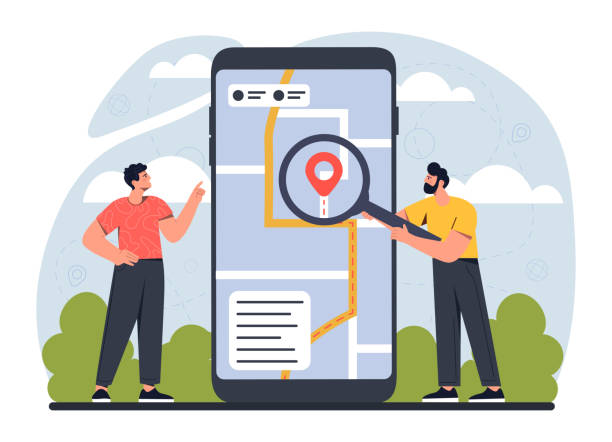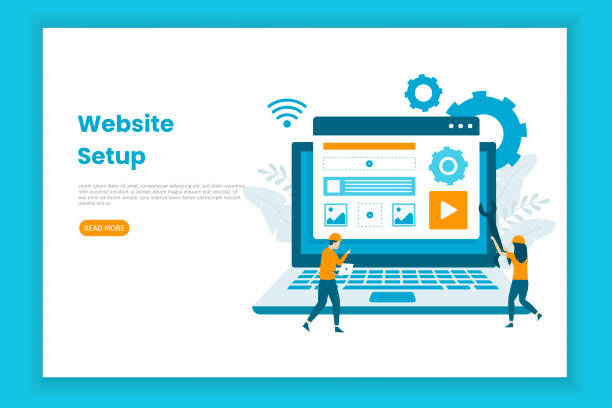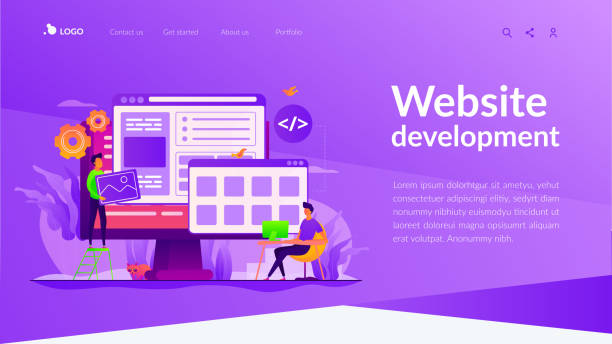An Introduction to Responsive Website Design: A Necessity for Every Business

In today’s world, where smartphones and tablets have become an inseparable part of our daily lives, the importance of responsive website design is felt more than ever.
This design approach, which allows websites to adapt to the user’s screen size, is no longer a luxury choice; rather, it is considered an essential necessity for every online business.
The main goal of responsive website design is to provide a flawless user experience (UX), regardless of the device the user employs to browse the site.
Indeed, this paradigm places #adaptive_website and #uniform_user_experience at its core.
Responsive sites automatically adjust their layout, font size, images, and navigation elements to provide the best display and functionality on smartphones, tablets, laptops, and even smart TVs.
Without this capability, mobile device users might encounter difficult navigation, small texts, and disproportionate images, leading to quick site abandonment and reduced engagement.
This issue not only results in a negative user experience but also adversely affects the site’s ranking in search engines.
Today, Google and other search engines give special priority to mobile-friendly sites and display them higher in search results.
Therefore, responsive design is not only vital for user satisfaction but also a key factor in SEO strategies.
This is an explanatory and educational step to understanding the fundamentals of this important technology.
Are you losing business opportunities because of an outdated website? With Rasawweb, permanently solve the problem of not attracting potential customers through your website!
✅ Attract more high-quality leads
✅ Increase brand credibility in the eyes of customers
⚡ Get free consultation for corporate website design
The Evolution of the Web and the Challenges of Diverse Devices

The web has come a long way since its early days.
Initially, websites were primarily designed for display on desktop monitors with fixed resolutions.
However, with the advent of smartphones in the 2000s and then tablets, the digital landscape rapidly changed.
Suddenly, users accessed the web from devices with completely different screen sizes and touch capabilities.
This shift posed significant challenges for web developers.
Sites optimized only for desktops were virtually unusable on mobile devices; the need for zooming, horizontal scrolling, and difficult navigation led users to quickly abandon sites.
Initially, some businesses responded to this challenge by creating separate mobile versions of their websites.
While this approach somewhat solved the problem, it had its drawbacks: maintaining two separate codebases, increased costs, and the potential for content and user experience inconsistencies between versions.
This analysis of the web’s past state indicated that a new approach was needed.
Then, the concept of responsive website design was introduced by Ethan Marcotte in 2010 and quickly became recognized as the superior solution.
Instead of building separate versions, this approach focuses on designing a single website that can intelligently adjust itself to any screen size.
This transformation was a newsworthy and exciting answer to the growing need for seamless web access across all devices and is considered a milestone in the history of web development.
Key Principles and Techniques in Responsive Design

Responsive website design is built upon three fundamental principles: Fluid Grids, Flexible Images, and Media Queries.
Fluid grids use relative units like percentages for element widths instead of fixed pixels.
This ensures that the website’s layout automatically scales with changes in screen size.
Flexible images, similarly, prevent content overflow by setting their width relatively (e.g., `max-width: 100%;`), ensuring images are always displayed proportionally to the available space.
The core of responsive design is Media Queries.
This capability in CSS3 allows developers to apply different styles based on device characteristics (such as screen width, resolution, or orientation).
For example, it can be specified that for widths less than 768 pixels, the navigation menu transforms into a hamburger icon.
The Mobile-First approach is also a specialized and very important principle in this field, recommending that design and development begin first for the smallest screens and then gradually expand for larger devices.
This method ensures that core functionality and content are delivered optimally on mobile devices and prevents the accumulation of unnecessary features in smaller versions.
Below is a table of some key CSS properties for responsive design:
| CSS Property | Description | Usage Example |
|---|---|---|
@media |
Apply styles based on device characteristics | @media (max-width: 768px) { ... |
width: % / max-width: % |
Create fluid widths for elements | .container { width: 90%; } |
img { max-width: 100%; height: auto; } |
Flexible images | img { max-width: 100%; height: auto; } |
flexbox / grid |
Advanced layout systems | display: flex; / display: grid; |
Tools and Frameworks for Responsive Development

To facilitate the process of responsive website design, numerous tools and frameworks have been developed that significantly simplify the work for developers.
One of the most popular and well-known frameworks is Bootstrap.
Bootstrap includes a comprehensive set of HTML, CSS, and JavaScript for quickly and easily developing responsive and mobile-friendly websites.
By providing ready-made UI components, a powerful Grid System, and many other features, this framework helps developers create highly responsive websites without needing to write CSS code from scratch.
In addition to Bootstrap, other frameworks like Foundation are also powerful options that offer similar tools.
However, if you are looking for more control and higher flexibility, CSS Grid and Flexbox are native and powerful tools in CSS that provide unparalleled capabilities for creating complex and responsive layouts.
Flexbox is excellent for laying out content in one dimension (row or column), while Grid is designed for creating two-dimensional layouts (rows and columns simultaneously).
Learning and mastering these specialized tools is essential for every modern web designer.
The choice of the right tool depends on the project’s needs and the developer’s experience level.
This section serves as a comprehensive guide for selecting appropriate technologies in responsive website design and provides an educational perspective for starting with these frameworks and native CSS tools.
Did you know that 94% of users’ first impressions of a business are related to its website design? With professional corporate website design by **Rasawweb**, turn this first impression into an opportunity for growth.
✅ Attract more customers and increase sales
✅ Build credibility and trust in the audience’s eyes⚡ Get free website design consultation!
User Experience (UX) in Responsive Design

User Experience (UX) holds immense importance in responsive website design.
A responsive site doesn’t just mean changing the visual layout; it must ensure that the user has the best, most engaging, and most useful experience on any device.
This includes elements such as text readability, ease of navigation, and the appropriate size of touchable elements (like buttons and links).
On mobile devices, screen space is limited, and navigation is primarily touch-based.
Therefore, buttons and links must be large enough to be easily touched and prevent accidental touches of adjacent elements.
Text readability is also crucial; font size, color contrast, and line spacing must be adjusted so that text is easily legible even on small screens.
Furthermore, navigation design (menu) must be simple and accessible.
Typically, in mobile versions, the menu transforms into a small hamburger icon that, when touched, opens the menu.
This is an example of optimizing user experience in responsive websites.
Responsive website design helps increase user satisfaction and, consequently, boosts conversion rates and reduces bounce rates.
A poor user experience can render even the best content ineffective.
This section provides a deep analysis of the importance of UX in responsive design and demonstrates how a successful design can impact user interaction and loyalty.
Performance Optimization in Responsive Sites

One of the critical aspects of responsive website design is its performance optimization, especially for mobile users.
Website loading speed is one of the most important factors in retaining users and improving search engine rankings.
Mobile users typically have access to slower internet networks and have high expectations for site loading speed.
Therefore, even if a site is visually responsive, if it has a slow loading speed, it will not provide a good user experience.
There are several specialized approaches to optimizing performance.
Image optimization is the first step.
Images should be served in appropriate sizes for each device and use modern, compressed formats (like WebP).
The Lazy Loading technique can also be helpful; this means that images and content “below the fold” are only loaded when the user scrolls to them.
Minification and compression of CSS and JavaScript files also help reduce file sizes and speed up loading.
Using a CDN (Content Delivery Network) to serve files from the closest server to the user can also dramatically increase speed.
All these measures not only improve the user experience but also contribute to site SEO, as search engines prioritize faster sites.
This aspect of responsive website design is often overlooked but is essential for a website’s long-term success and is considered part of challenging content for developers: how can the best speed be ensured alongside responsiveness?
Common Challenges and Solutions in Implementing Responsiveness

Although responsive website design offers countless benefits, its implementation also comes with challenges that require specialized solutions.
One of the main challenges is managing complex content and data tables on small screens.
Large, information-rich tables can become cluttered and unreadable on mobile devices.
Solutions such as hiding less important columns, using scrollable tables, or converting tables into individual cards on mobile can be helpful.
Another challenge is performance and loading speed, which we addressed in the previous section.
High-resolution images and heavy scripts can significantly increase loading times.
Using image optimization tools, code compression, and lazy loading are solutions to this problem.
Testing and debugging across different devices is also a significant challenge.
With the countless variations of devices and screen sizes, ensuring flawless performance on all of them is difficult.
Using emulators in browsers (like Chrome DevTools) and real device testing platforms (like BrowserStack or LambdaTest) is essential for this purpose.
Complex navigation can also be problematic on mobile.
Designing simple and user-friendly menus, using clear icons, and providing easy access to the main sections of the site are of high importance.
These are among the challenging contents that every developer should consider.
Responsive website design requires strategic thinking and anticipating potential problems to ensure an consistently excellent user experience.
The table below lists some common challenges and their solutions:
| Challenge | Description | Solutions |
|---|---|---|
| Displaying large tables | Tables become cluttered and unreadable on mobile. | Horizontal scrolling, hiding columns, converting to cards. |
| Performance and speed | Heavy images and excessive code reduce speed. | Image optimization, Minification, Lazy Loading. |
| Testing on different devices | Device variety complicates testing. | Emulator tools, real device testing. |
| Complex navigation | Cluttered menus on mobile disrupt user experience. | Hamburger menu, simple navigation, clear icons. |
The Business Impact of Responsive Design on SEO and Conversion Rates

The impact of responsive website design extends beyond an excellent user experience; this approach directly affects the business success of an online enterprise.
One of the most significant impacts is the improvement of SEO (Search Engine Optimization).
Google and other search engines have explicitly stated that they prioritize mobile-friendly sites in their search results.
Since July 2019, Mobile-First Indexing has been introduced as Google’s primary standard, meaning Google primarily considers the mobile version of your website for ranking and indexing.
Therefore, if your site is not responsive, you will likely rank lower in mobile and even desktop search results.
In addition to SEO, responsive website design significantly increases the Conversion Rate.
When users can easily navigate your site and view content on any device, they are more likely to perform your desired action (such as purchasing a product, filling out a form, or contacting you).
The Bounce Rate also decreases because users do not abandon the site due to a negative experience.
A site with responsive design also reduces maintenance costs, as there is only one codebase to manage instead of two versions (desktop and mobile).
This is a significant competitive advantage for businesses, enabling them to reach a wide range of audiences and stand out in today’s competitive digital market.
This is an in-depth analysis of business impacts and has a newsworthy and important nature for every business owner.
Are you tired of your e-commerce site having visitors but no sales? Rasawweb solves your main problem with professional e-commerce website design!
✅ Significant increase in sales with targeted design
✅ Flawless user experience for your customers
⚡ Get free consultation!
Future Trends in Responsive Design and Web Development

The world of web development is constantly evolving, and responsive website design is no exception.
Future trends promise even richer and more integrated user experiences.
One of the most important upcoming trends is Progressive Web Apps (PWAs).
PWAs offer a combination of the best features of the web and native applications; they can be installed on the phone’s home screen, work offline, and send push notifications, all while maintaining the nature of a responsive website.
This technology provides an engaging and highly practical experience.
In addition to PWAs, continuous advancements in CSS, such as new features in Grid and Flexbox, provide more possibilities for creating dynamic and complex layouts.
Also, the emergence of Artificial Intelligence (AI) and Machine Learning (ML) in design and development tools can optimize the process of building responsive websites, from automated code generation to automatic image optimization.
Responsive design is moving towards greater intelligence, where websites respond not only to screen size but also to user needs, network speed, and even location.
This forward-looking approach will elevate the user experience to a higher level.
Furthermore, there’s increasing emphasis on highly accessible websites (Accessibility), meaning responsive website design must ensure that the site is also usable for people with disabilities.
This is a newsworthy and exciting vision of a future where websites will be increasingly intelligent and inclusive.
The Importance of Education and Updates in Responsive Design
![]()
Given the rapid changes in the web domain, continuous education and updating knowledge in the field of responsive website design is essential for every web designer and developer.
What is considered best practice today may be replaced by new technologies tomorrow.
A deep understanding of CSS Grid and Flexbox principles, familiarity with the latest JavaScript features, and performance optimization all require continuous learning.
There are countless online educational resources, from specialized courses to technical articles and blogs that regularly provide new information.
Participating in webinars, conferences, and online communities can also help exchange knowledge and resolve challenging content.
It is also important for businesses to be aware of these trends and not hesitate to invest in responsive design and update their websites.
An old and non-responsive website not only harms the user experience but also damages brand credibility and destroys business opportunities.
Continuous education and updating not only help developers remain competitive in the job market but also ensure that websites are at the highest level in terms of performance and security.
This section is a guide and a reminder that knowledge and expertise in this field should never stop.
Frequently Asked Questions
| Question | Answer |
|---|---|
| What is responsive website design? | It is a web design approach aimed at creating websites that can automatically adapt to the user’s screen size and device (computer, tablet, mobile) to provide the best user experience. |
| Why is responsive design important? | Its importance has grown due to the increasing variety of devices people use to access the internet. This design improves user experience, boosts search engine rankings (SEO), and reduces maintenance costs. |
| How is responsive design implemented? | By using CSS techniques such as Media Queries (which allow you to change styles based on device characteristics like screen width), Fluid Grids, and Flexible Images. |
| What are the key principles of responsive design? | The three main principles are: Fluid Grids (using relative units like percentages instead of pixels for widths), Flexible Images (adapting image sizes to available space), and Media Queries (applying different styles based on screen characteristics). |
| What are the benefits of having a responsive website? | Providing a seamless user experience across all devices, improved SEO, increased user time on site, reduced bounce rate, easier site management and updates (only one codebase). |
And other services of Rasawweb Advertising Agency in the field of advertising
Smart Social Media: A combination of creativity and technology for online growth using real data.
Smart Advertising Campaign: Revolutionize click-through rates with custom user experience.
Smart Conversion Rate Optimization: An innovative service to increase sales through Google Ads management.
Smart Marketing Automation: A professional solution for analyzing customer behavior with a focus on custom programming.
Smart Social Media: A professional solution for analyzing customer behavior with a focus on intelligent data analysis.
And over a hundred other services in the field of internet advertising, advertising consultation, and organizational solutions
Internet Advertising | Advertising Strategy | Advertorial
Resources
Comprehensive Guide to Responsive Website Design
Future of Web Technologies
Success Factors in Responsive Design
Responsive Design: Key to the Modern Web
? To shine in the digital world and reach the peak of success, Rasawweb Digital Marketing Agency is with you with its comprehensive services, including responsive website design.
📍 Tehran, Mirdamad Street, next to Bank Markazi, Kazeroun Jonubi Alley, Ramin Alley, No. 6

